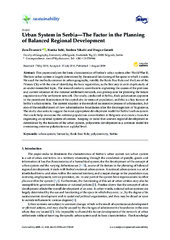Приказ основних података о документу
Urban System in Serbia-The Factor in the Planning of Balanced Regional Development
| dc.creator | Živanović, Zora | |
| dc.creator | Tošić, Branka | |
| dc.creator | Nikolić, Teodora | |
| dc.creator | Gatarić, Dragica | |
| dc.date.accessioned | 2021-09-24T15:43:19Z | |
| dc.date.available | 2021-09-24T15:43:19Z | |
| dc.date.issued | 2019 | |
| dc.identifier.issn | 2071-1050 | |
| dc.identifier.uri | https://gery.gef.bg.ac.rs/handle/123456789/991 | |
| dc.description.abstract | This paper analyzes the basic characteristics of Serbia's urban system after World War II. The term urban system is largely determined by the use and functioning of the space in which it exists. We used the methods common in urban geography, notably the Rank-Size Rule and the Law of the Primate City with the aim of identifying the basic regularities, as the first step in an in-depth study of an under-researched topic. The research seeks to contribute to explaining the causes of the previous and current situation in the national settlement network, as a prerequisite for planning the future organization of the settlement network. Our study, conducted in Serbia, finds polarization apparent in the prominent domination of the capital city in terms of population, and this is a key feature of Serbia's urban system. The current situation is the result of an intensive process of urbanization, but also of the establishment of new administrative boundaries after the disintegration of Yugoslavia. The study also seeks to suggest the most appropriate development model for Serbia's urban system that could help overcome the extreme population concentration in Belgrade and create a basis for organizing an optimal system of centers. Keeping in mind that uneven regional development is determined by the features of the urban system, polycentric development is a common model for overcoming extreme polarization on a global level. | en |
| dc.publisher | Basel : MDPI | |
| dc.relation | info:eu-repo/grantAgreement/MESTD/Basic Research (BR or ON)/176017/RS// | |
| dc.relation | info:eu-repo/grantAgreement/MESTD/Integrated and Interdisciplinary Research (IIR or III)/47006/RS// | |
| dc.relation | info:eu-repo/grantAgreement/MESTD/Integrated and Interdisciplinary Research (IIR or III)/47014/RS// | |
| dc.rights | openAccess | |
| dc.source | Sustainability | |
| dc.subject | urban system | en |
| dc.subject | hierarchy | en |
| dc.subject | Rank-Size Rule | en |
| dc.subject | polycentricity | en |
| dc.subject | Serbia | en |
| dc.title | Urban System in Serbia-The Factor in the Planning of Balanced Regional Development | en |
| dc.type | article | |
| dc.rights.license | ARR | |
| dcterms.abstract | Николић, Теодора; Живановић, Зора; Тошић, Бранка; Гатарић, Драгица; | |
| dc.citation.volume | 11 | |
| dc.citation.issue | 15 | |
| dc.citation.other | 11(15): - | |
| dc.citation.rank | M22 | |
| dc.identifier.wos | 000485230200173 | |
| dc.identifier.doi | 10.3390/su11154168 | |
| dc.identifier.scopus | 2-s2.0-85070451595 | |
| dc.identifier.fulltext | https://gery.gef.bg.ac.rs/bitstream/id/885/989.pdf | |
| dc.identifier.rcub | https://hdl.handle.net/21.15107/rcub_gery_991 | |
| dc.type.version | publishedVersion |


